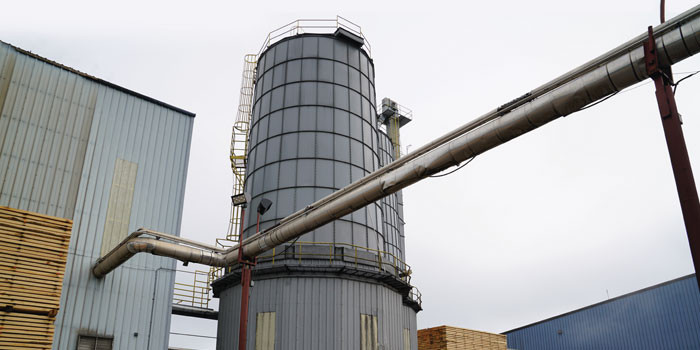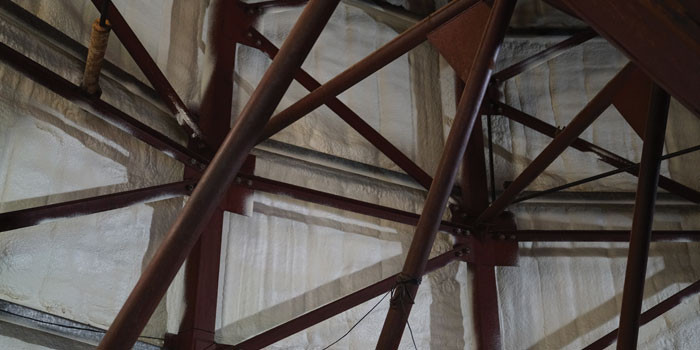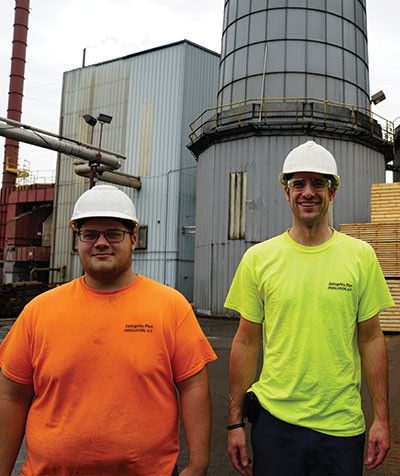Silo Solution


SPRING 2019 – The Biewer Wisconsin Sawmill, located in Prentice, Wisconsin, is Biewer’s second built sawmill and one of five within the Biewer Sawmills family. The sawmill is a fully automated, modern, high tech facility vertically integrated to provide the highest-quality building products for Biewer customers. The sawmill is considered one of the largest-volume, random-length mills in the Midwest. The sawmill specializes in nearly 100 million board feet of boards, dimension and timbers for the treating and construction industry. Its main species include Red Pine and SPF-s (note this is a tree species rather than a spray foam reference!).
A third generation, family-owned and operated business, Biewer’s sawmill basic operational process is much like it was 100 years ago—a log enters one end and dimensional lumber exits on the other end. However, the process today is much more sophisticated. Now, after a log enters the mill, it is de-barked and bucked to length and then it is scanned. Next, a computer determines the best yield for that particular piece of timber, be it dimensional lumber, timbers, or both.
Biewer encourages environmentally responsible sustainable forestry practices. The company’s decision to insulate its Biewer Wisconsin Sawmill with Lapolla FOAM-LOK 2000 4G shows that commitment. “Cold is everything.” That description from Ralph Moser, kilns supervisor at Biewer Wisconsin Sawmill, is at the heart of why closed-cell spray polyurethane foam was installed inside a large silo at the mill to prevent boiler fuel stored within it from freezing. This sole fuel source, consisting of sawdust and bark, is typically moist and therefore susceptible to freezing inside the mill’s silos during the winter season, which is notoriously intense in Wisconsin. If frozen, the sawdust and bark is unable to flow freely down and out of the silos to the boiler, which can cause the entire mill to shut down. Should this freeze scenario occur, the ceased operations negatively affect the mill’s production.

FOAM-LOK 2000 4G closed-cell spray foam was installed inside a large silo at the mill to prevent boiler fuel stored within it from freezing. The installation crew had to maneuver around piping and cross beams to apply the foam to the interior of the silo.
Biewer Wisconsin Sawmill does not utilize gas back-up. This means that the mill uses very expensive torpedo heaters inside the silos to prevent freezing. And, when necessary, they use those same torpedo heaters to thaw the sawdust and bark during a freeze. The approach is both costly and inefficient and the primary reason that spray polyurethane foam was sought out as a solution for the mill. As Moser notes, “The price of a heater is comparable to the cost of the whole insulation job,” indicating that SPF was selected to prevent the freeze effect, but also as a bottom-line business decision.
The silo sprayed with SPF is cylindrical and large with an imposing 25-foot height and 30-foot diameter. The mill’s management had previously tried rigid sheet insulation methods for its silos which is how they came to realize they really needed to identify an insulation solution that would both contour and fully adhere to the metal walls, which the rigid options couldn’t do.
Chosen for their responsiveness and proven capabilities, Integrity Plus Insulation installed two inches of the Lapolla FOAM-LOK 2000 4G closed-cell spray polyurethane foam, manufactured by Icynene-Lapolla and formulated with Honeywell’s Solstice® Liquid Blowing Agent, into one of the mill’s two silos. A high-performance SPF insulation that eliminates Ozone Depletion Potential (ODP) and dramatically reduces Global Warming Potential (GWP), the insulation also reduces a structure’s energy demands and related energy bills up to 45 percent (for the life of the structure).
“I’ve sprayed nothing but the Lapolla FOAM-LOK 4000 4G system with Honeywell’s Solstice® LBA for over two years because of how it performs,” says Eric Gladson, founder and owner of Integrity Plus Insulation. “I’m loyal to it.”
“Closed-cell spray foam is ideal for this structure,” adds Kelly Pickering, western regional supervisor with Icynene-Lapolla’s technical department. “Not only will it prevent the material from freezing in the silo, it will also provide an air and vapor barrier that will reduce air leakage and condensation that can build up. Also, the strength of the foam will make the structure sturdier.”
Spraying foam inside the silo admittedly posed a series of unique challenges for the Integrity Plus Insulation crew however. “One of the more prevalent challenges was the constant need to maneuver around piping, numerous cross beams, heaters, and other obstructions within the silo itself,” says Gladson.
The use of a lift allowed the Integrity Plus team to start spraying at the top of the silo and work their way down. However, there were very few places within the silo where they could easily spray one section, then move down and repeat without obstruction. Gladson indicates only about one-fourth of the installation was unobstructed by pipes, beams, and equipment.
While the use of a lift helped, it too posed challenges. The vertical lift used features a 4-foot by 2.5-foot basket that the installer had to climb into, then tie off. At the very top of the inside of the silo, it became a very tight and constrained area to spray, as the silo features a hopper in the center which acts much like a funnel extending down to the conveyer at the bottom of the silo. The hopper has a wide girth at the top of the silo, and coupled with protruding beams and equipment, the application was difficult in those areas.
Installation occurred in four foot wall sections. With the completion of each section, the lift needed to be positioned for the application of spray foam in the next section. Gladson points out that there was an excessive amount of maneuvering with this project exacerbated by the numerous obstructions. In some areas of the silo, Gladson and his crew had to actually get out of the vertical lift basket and stand on beams within the silo in order to complete installation of the SPF. Of course, the installers followed all appropriate safety measures.

The Integrity Plus Insulation crew (pictured here–Jared Hartmann, left, and Eric Gladson, right) installed Icynene-Lapolla foam formulated with Honeywell’s Solstice® Liquid Blowing Agent into one of the sawmill’s two silos.
Gladson describes the installation of the SPF. “It was better than expected. It layed in nicely and we got great yields and adhesion.”
For Biewer, the SPF installation in the silo is key for five reasons—increased plant reliability; dramatic reduction of heating costs; prevention of freezing fuel material inside the silo ensuring product output; steady fuel flow and boiler pressure; as well as sturdier silo walls. The Biewer Wisconsin Sawmill management is so pleased with the measurable results that they are planning to have their second silo at the mill insulated as well, which will more than double the energy savings attributed to SPF (because the second silo is larger than the first).
For Biewer Wisconsin Sawmill, the entire
purpose of this project centered around environmental sustainability. The company works to reduce its Earth impacts where it can. Responsible forestry is one area, and energy is another. Because the torpedo heaters inside the silos require so much electricity, lowering the demand for them is one primary way the sawmill can reduce its fossil fuel consumption, as well as the emissions and air pollution that result from it. The SPF insulation helps to control the temperature inside the silo, preventing the extreme freezing of the fuel contents inside of it as well as the use of the heaters to rectify the issue.
“The spray foam is truly a win-win for them,” says Gladson.
ABOUT THE AUTHOR Doug Kramer is President & CEO of Icynene-Lapolla, the global manufacturer, supplier and leader in spray polyurethane foam. The company’s products, including the two applied in this restoration project, are recognized for optimizing energy efficiency and performance in the envelope. Doug Kramer may be reached at dkramer@icynene-lapolla.com.
Disqus website name not provided.





































